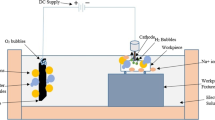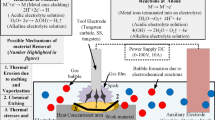Abstract
In this study, a finite element model (FEM) with 2D Gaussian heat distributed has been developed to predict and calculate the material removal rate (MRR) of quartz glass using electrochemical discharge machining (ECDM) process. Quartz is an important engineering material and exhibits a wide range of applications due to its better properties over other forms of glass such as higher strength to weight ratio, high workable temperature, hardness, and melting point. These properties offer a machining challenge and response estimation is also a strenuous task. The ECDM is a nonconventional hybrid process combining the characteristics of electric discharge machining (EDM) and electrochemical machining (ECM), which has the potential to machine such materials. The thermal spark is considered as material removal mechanism by assuming the shape of the formed craters as hemispherical. The effect of electrolyte concentration and the applied voltage is studied on the material removal rate. The developed model is validated with previously published research and present confirmation experiments. The results show that the model has close behavior with experimental values and slight variation is also observed due to the assumptions made during development.
Access this chapter
Tax calculation will be finalised at checkout
Purchases are for personal use only
Similar content being viewed by others
References
Singh J, Vaishya R, Kumar M (2019) Fabrication of micro features on quartz glass using developed WECDM setup. ARPN J Eng Appl Sci 14:725–731
Kumar M, Vaishya RO, Oza AD, Suri NM (2020) Experimental investigation of wire-electrochemical discharge machining (WECDM) performance characteristics for Quartz material. Silicon 12:2211–2220. https://doi.org/10.1007/s12633-019-00309-z
Gottmann J, Hermans M, Repiev N, Ortmann J (2017) Selective laser-induced etching of 3D precision quartz glass components for microfluidic applications-up-scaling of complexity and speed. Micromachines 8:110. https://doi.org/10.3390/mi8040110
Lin SY, Chen JZ (2017) Effect of various assisted machining technique applications on cutting performance of quartz glass milling. In: Proceedings 2017 IEEE international conference on applied system innovation Mod Technol ICASI 2017, pp 1583–1586. https://doi.org/10.1109/ICASI.2017.7988232
Witzendroff PV et al (2018) Additive manufacturing of glass: CO2-Laser glass deposition printing. In: 10th CIRP conference on photonic technologies [LANE 2018] Procedia CIRP 74:272–275. https://doi.org/10.1016/j.procir.2018.08.109
Hou R, Wang T, Lv Z, Liu Y (2018) Experimental study of the ultrasonic vibration-assisted abrasive waterjet micromachining the Quartz glass. Adv Mater Sci Eng. https://doi.org/10.1155/2018/8904234
Crichton IM, McGeough JA (1985) Studies of the discharge mechanisms in electrochemical arc machining. J Appl Electrochem 15:113–119. https://doi.org/10.1007/BF00617748
Kurafuji H, Suda K (1968) Electrical discharge drilling of glass. Ann CIRP 16:415–418
Basak I, Ghosh A (1997) Mechanism of material removal in electrochemical discharge machining: a theoretical model and experimental verification. J Mater Process Technol 71:350–359. https://doi.org/10.1016/S0924-0136(97)00097-6
Basak I, Ghosh A (1996) Mechanism of spark generation during electrochemical discharge machining: a theoretical model and experimental verification. J Mater Process Technol 62:46–53. https://doi.org/10.1016/0924-0136(95)02202-3
Singh D, Goud M (2018) A 3D spark model to evaluate MRR in ECDM. J Adv Manuf Syst 18:435–446. https://doi.org/10.1142/S0219686719500239
Wei C, Xu K, Ni J et al (2011) A finite element based model for electrochemical discharge machining in discharge regime. Int J Adv Manuf Technol 54:987–995. https://doi.org/10.1007/s00170-010-3000-0
Panda MC, Yadava V (2009) Finite element prediction of material removal rate due to traveling wire electrochemical spark machining. Int J Adv Manuf Technol 45:506–520. https://doi.org/10.1007/s00170-009-1992-0
Paul L, Korah LV (2016) Effect of power source in ECDM process with FEM Modeling. Procedia Technol 25:1175–1181. https://doi.org/10.1016/j.protcy.2016.08.236
Goud M, Sharma AK (2017) A three-dimensional finite element simulation approach to analyze material removal in electrochemical discharge machining. Proc Inst Mech Eng Part C J Mech Eng Sci 231:2417–2428. https://doi.org/10.1177/0954406216636167
Dhiman P, Vaishya R, Kumar M (2019) A review on machining by electrochemical discharge phenomena. Int J Tech Innov Mod Eng Sci 5:71–74
Singh M, Singh S (2020) Sustainable electrochemical discharge machining process: characterization of emission products and occupational risks to operator. Mach Sci Technol. https://doi.org/10.1080/10910344.2020.1752238
Bhondwe KL, Yadava V, Kathiresan G (2006) Finite element prediction of material removal rate due to electro-chemical spark machining. Int J Mach Tools Manuf 46:1699–1706. https://doi.org/10.1016/j.ijmachtools.2005.12.005
Wang YK, **e BC, Wang ZL, Peng ZL (2011) Micro EDM deposition in air by single discharge thermo simulation. Trans Nonferrous Met Soc China 21:450–455. https://doi.org/10.1016/S1003-6326(11)61623-3
Kulkarni A, Sharan R, Lal GK (2003) Measurement of temperature transients in the electrochemical discharge machining process. AIP Conf Proc 684:1069–1074. https://doi.org/10.1063/1.1627271
Rajput V, Goud M, Suri NM (2020) Performance analysis of ECDM process using surfactant mixed electrolyte. In: Sharma V, Dixit U, Sørby K, Bhardwaj A, Trehan R (eds) Manufacturing engineering, Springer, Singapore, pp 285–300. https://doi.org/10.1007/978-981-15-4619-8_22
Rajput V, Goud MM, Suri NM (2019) Experimental investigation to improve the removal rate of material in ECDM process by utilizing different tool electrode shapes. Int J Techn Innov Modern Eng Sci (IJTIMES) 5:333–341
Kumar M, Vaishya RO, Suri NM (2020) Machinability study of Zirconia material by micro-ECDM. In: Sharma V, Dixit U, Sørby K, Bhardwaj A, Trehan R (eds) Manufacturing engineering, Springer, Singapore, Pp 195–209. https://doi.org/10.1007/978-981-15-4619-8_15
Oza AD, Kumar A, Badheka V, Arora A (2019) Traveling wire electrochemical discharge machining (TW-ECDM) of Quartz using zinc coated brass wire: investigations on material removal rate and Kerf width characteristics. Silicon 11:2873–2884. https://doi.org/10.1007/s12633-019-0070-y
Bindu MJ, Hiremath SS (2019) Machining and characterization of channels and textures on Quartz glass using μ-ECDM process. Silicon 11:2919–2931. https://doi.org/10.1007/s12633-019-0083-6
Oza AD, Kumar A, Badheka V (2020) Improving quartz micro-machining performance by magnetohydrodynamic and zinc-coated assisted traveling wire-electrochemical discharge machining process. Mater Today Proc 28:970–976. https://doi.org/10.1016/j.matpr.2019.12.334
Author information
Authors and Affiliations
Corresponding author
Editor information
Editors and Affiliations
Rights and permissions
Copyright information
© 2021 The Author(s), under exclusive license to Springer Nature Singapore Pte Ltd.
About this paper
Cite this paper
Kumar, M., Vaishya, R.O., Suri, N.M. (2021). FEM-Based Thermal Modeling for Analyzing ECDM Process. In: Kumar, S., Rajurkar, K.P. (eds) Advances in Manufacturing Systems. Lecture Notes in Mechanical Engineering. Springer, Singapore. https://doi.org/10.1007/978-981-33-4466-2_19
Download citation
DOI: https://doi.org/10.1007/978-981-33-4466-2_19
Published:
Publisher Name: Springer, Singapore
Print ISBN: 978-981-33-4465-5
Online ISBN: 978-981-33-4466-2
eBook Packages: EngineeringEngineering (R0)




